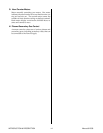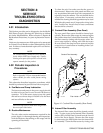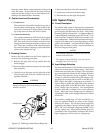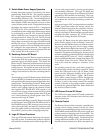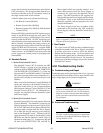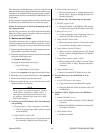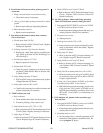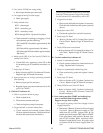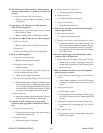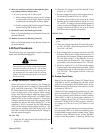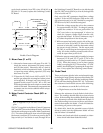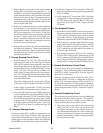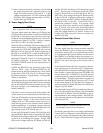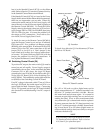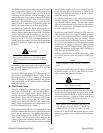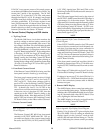
SERVICE TROUBLESHOOTING 22 Manual 0-2533
M. DC indicator off (after pre-flow); Main contactor
comes on momentarily; No pilot arc; No main arc
transfer
1. Switching transistor (Q1) not turning on
a. Refer to Section 4.05-M, Switching Control
Check (Q1).
N. No pilot arc; DC indicator on; Pilot indicator
OFF; PCR not energized
1. Faulty Logic PC Board, Switching Control PC Board,
or Shunt Amp PC Board.
a. Refer to Section 4.05-N, Pilot Circuit Check.
O. No pilot arc; PILOT indicator on; PCR energized
1. Faulty Arc Start Box
a. Refer to Section 4.05-N, Pilot Circuit Check.
2. Shorted torch
a. Refer to Section 4.05-N, Pilot Circuit Check.
P. Weak or sputtering pilot
1. Faulty torch consumable parts
a. Replace consumables as needed
2. Plasma gas pressure too high
a. Adjust pressure
3. Low OCV (normal 290-350) caused by improper con-
nection of voltage selection bus bars
a. Check input voltage connections
4. Low OCV caused by faulty Voltage Selection PC Board
a. If three-phase input voltage is within the lower
half of range (refer to Operating Manual Sec-
tion 3.07, Input Voltage Selection), D18 on Volt-
age Selection PC Board should be off. If D18 is
on, replace the Voltage Selection PC Board.
5. Input voltage low
a. Adjust pilot resistor for less resistance. Refer to
Section 4.05-R, Pilot Resistor Adjustment.
Q. No pilot; PILOT indicator on; Strong spark
visible at spark gap points inside the Arc Starter
Box
1. Electrode shorted against tip
a. Thread electrode securely into torch head or
replace tip and electrode
2. Shorted torch head
a. Check and replace if necessary
3. Broken conductor in torch lead
a. Check and replace if necessary
4. Shorted torch lead
a. Check and replace if necessary
5. Dirty or wet torch lead
a. Clean and dry torch lead
R. Pilot arc on; No main arc transfer (torch brought
within range of work)
1. Work cable not connected
a. Connect work cable securely
2. Defective current control pot (on front panel or remote)
a. If Remote Control is used, disconnect J15 and
set current at power supply front panel. If trans-
fer is correct or Remote Control is not used, re-
fer to Section 4.05-O, Current Control, Display,
and CSD Checks.
S. Main arc starts but goes out immediately; Main
contactor (W1 or W2) goes off
1. Fault condition causes output greater than 175 amps
a. Shorted Q1 or faulty Switching Control PC
Board. Refer to Section 4.05-M, Switching Con-
trol Check (Q1).
T. Main arc transfers but doesn’t pierce through the
plate or pierce is too slow
1. Corner slowdown (CSD) setting too low on Remote
Control.
a. Most cutting machines activate CSD during
piercing, if so CSD must be set at or near maxi-
mum.
2. Cutting current too low
a. Set for higher current
b. Current control circuit defective. Refer to Sec-
tion 4.05-O, Current Control, Display and CSD
Checks.
3. Trying to pierce greater than 3/4 inch (19 mm) plate
a. Unit rated only for piercing upto 3/4 inch (19
mm)
4. Travel speed too high
a. Try a stationary pierce, if piercing is correct, then
adjust travel speed



